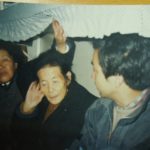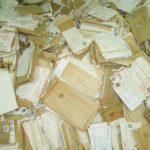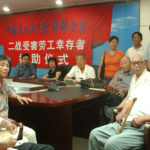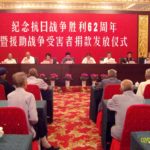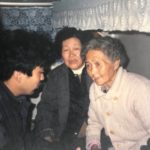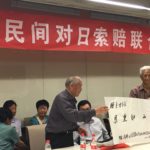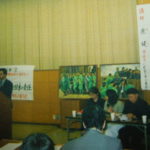Introduction: This page describes the thousands of letters that Mr. Tong Zeng received during the early part of the decade of the 1990s. All the letters can be searched and displayed using the search capabilities described in the “Search” page.
To give the reader an overall impression of these letters without requiring the reader to spend a large amount of time reading hundreds or thousands of letters, near the end of this article, we briefly describe ten sample letters. Reading the summary of these 10 sample letters will accomplish that purpose.
As discussed in the “Home” page (also known as the “Site Overview” page) and in the “About Us” page, starting in 1990-1991, Mr.Tong Zeng initiated a campaign to seek compensation from Japan for Chinese citizens who were victims of atrocities suffered at the hands of the Japanese military during the Second Sino-Japanese War (1931-1945). Immediately after this campaign was reported in the Chinese media, an avalanche of letters was sent to Mr. Tong. Many of the letter writers did not know Mr. Tong’s address and simply addressed their letters to Mr. Tong Zeng, Beijing, China. Most such letters initially were sent back to the senders. However, after a while, even without the full address, such letters were sent properly to Mr.Tong’s address.
Many of the victims were senior citizens and not necessarily highly educated. To facilitate such people reporting their experiences, in some localities, people prepared “Form-Letters” for the victims to fill in the information related to their own experience.
Within a few years, Mr. Tong received about 10,000 letters and formed-letters. Over the next few years, many newspaper reporters and relatives or friends of the victims or letter writers asked Mr. Tong to borrow many of the letters and form-letters. Since copying machines were not widely available 20+ years ago in Chinese offices and homes, a large number of these letters and form-letters were borrowed and never returned. As a result, Mr. Tong now has only about 5,000 letters and form-letters in his possession (about 3,700 letters and about 1,200 form-letters).
Description of the Structure and Classification of the Letters: We now describe the letters received and the archival process we use to facilitate the classification and retrieval of this vast amount of information. In the “Form Letters” page, we will do likewise for the form letters.
Our objective is to provide a digital archive of the letters. This has several advantages over the original handwritten paper letters:
- The original paper letters will deteriorate with age or with multiple use and handling
- The digital letters can be easily shared across the whole world, and there can be multiple simultaneous users
- The digital letters can be easily duplicated and backed up to prevent loss due to fire, theft, and other disasters
- One can do searches on the digital letters to make it much easier to find certain types of letters and to do statistical analysis.
- This digital archive of these historical written testimonies of victims can facilitate additional research and historical analysis of that part of WWII history.
For each letter, we have the following documents:
- Scanned image of envelope(s): This is an electronic photo copy of the envelope. It is a .jpg file.
- Scanned image of each page of the original letter written in Simplified Chinese. This is an electronic photo copy of each page of the letter. It is a .jpg file.
- Digital file of the transcribed Simplified Chinese letter. This is a manual transcription of the Simplified Chinese letter. It provides a digital file that can allow searches. It is a .doc file. Because the original letters were handwritten on mostly thin papers, using Optical Character Recognition (OCR) to automatically transform the scanned image files into digital files does not capture the contents accurately enough.
- Digital file of the transcribed Chinese letter using Traditional Chinese. This is just a machine conversion (with manual review and changes as necessary) of the Simplified Chinese letter file into a Traditional Chinese letter file. It is a .doc file.
- Digital file of the English translation of the original Chinese letter. This is a translation of the Simplified Chinese letter into English by a bilingual person. It is a .doc file.
So each letter has a set of documents associated with that letter.
For each scanned document, we assign it a unique identifier ID. For example, for the scanned image of the first envelope, its ID is s0001-e1. The letter “s” denotes that this is a scanned document. The four digits after the letter “s” can accommodate up to 10,000 such documents. The letter “e” denotes that this is an envelope. Because in a few cases, there may be more than one envelope associated with a letter, we provide a number after the letter “e” to denote the first, second, envelope, etc. Almost all letters have only one envelope.When there is no number after the letter “e”, it means that the letter has only one envelope.
For the scanned image of the first letter, its ID is s0001-p1, s0001-p2, s0001-p3, etc. to denote the first page, second page, third page, etc. of the first letter.
For the transcribed Simplified Chinese first letter, its ID is s0001s, with the second “s” denoting that this is a transcribed Simplified Chinese file. Because the transcribed file is for the whole letter, and not for individual pages of the letter, it is not necessary to introduce page number in the ID.
For the transcribed Traditional Chinese first letter, its ID is s0001t, with the letter “t” denoting Traditional Chinese.
For the English translation of the first Chinese letter, its ID is s0001g, with the letter “g” denoting English. (The letter “e” is already used to denote envelopes. That is why we use the letter “g” to denote English translation.)
So there are multiple documents associated with each letter. We use the ID s0001 to denote the folder that contains the whole set of documents associated with the first letter.
The naming convention and unique identifiers for the first letter are summarized in the following table (for the naming convention and unique identifiers for any other letter, just replace s0001 with the unique ID of that other letter):
| Type of Document | Unique ID | Type of File |
| Scanned Envelope | s0001-e1, s0001-e2, etc. | .jpg |
| Scanned Chinese Letter | s0001-p1, s0001-p2, s0001-p3, etc. | .jpg |
| Digital Transcribed Simplified Chinese Letter | s0001s | .doc |
| Digital Transcribed Traditional Chinese Letter | s0001t | .doc |
| Digital Translated English Letter | s0001g | .doc |
| Folder containing the whole set of documents associated with the first letter | s0001 | Folder |
Table: Unique identifiers to denote various documents for the first letter s0001
Every letter contains the following information:
- Type of atrocity (We classify the atrocities into nine types: Slave Laborers (SL), Murders (MU, not part of Nanking Massacre or Other Massacres), Air Bombings (AB), Rapes (RA, not part of Sex Slaves), Other Massacres (OM), Biological/Chemical Warfare (BC), Sex Slaves (SS), Nanking Massacre (NM) and Others (OT). It is possible that an event is associated with more than one category. For example, an event involving a woman being raped and then killed would be classified under both RA and MU.)
- Date of event
- Name(s) of victim(s)
- Location of event
- Date of letter
- Name of author
- Address of author
- Other details (information such as the number of people killed, raped, or injured, amount of property damaged, etc.)
Besides these eight pieces of information, each letter, as already discussed, also has a unique ID(also called sequence number) that identifies the folder containing all the documents associated with that letter. Therefore, each letter can be characterized by an “Index File” spreadsheet with nine indices. This spreadsheet Excel file with its indices is used to facilitate the searching of the contents of the letters, as explained and can be tried in the “Search” page.
Ten Sample Letters: You can get a good overall impression of these thousands of letters by reading the summary of the following 10 sample letters; all nine categories of atrocity are represented in these 10 sample letters.
-
-
- s1031 (Murders-MU): This writer is typical of many other letter writers in which she was reluctant to recall the past atrocities because it is so painful to relive through them again. However, she also understands that these painful memories must not be forgotten; so she decided to share her experiences in order to seek justice. The letter was written in Chongqing on February 18, 1993 by Shi Shuhua (施淑华) who wrote the letter on behalf of her nephew Shi Jing Yin (施竞阴). Like so many other families all over China during 1931-1945, he and his family’s lives were always about running and hiding from Japanese air raids or about pulling up roots to escape from the Japanese invading army, while suffering unimaginable hardships and deaths. Three of his eight family members (his father, older brother, and older sister) perished, and the other five barely escaped death several times.
- s1380 (Sex Slaves-SS): This letter was compiled in December 1992 by Mr. Zhang Shuangbing (张双兵) of the testimonies of 10 former Chinese sex slaves all from the Shanxi Province. A common theme of these testimonies is that these women/girls were seized against their wills and subjected to unimaginable savage beatings and rapes over an extended period. The physical tortures they suffered resulted in a lifetime of physical and mental sufferings. Often when their bodies had deteriorated so much that they could no longer function, then the Japanese soldiers would request their families for a large sum of money or goods in exchange for the release of these women/girls.
-
Mr. Zhang Shuangbing has found and interviewed a large number of former sex slaves of Shanxi Province, and has published a book on his findings: 《炮楼里的女人–山西日军性奴隶调查实录》, 作者是 张双兵, 江苏人民出版, 2011.
-
-
- s1950 (Air Bombing-AB): This is an August 1,1993 letter written by Mr. Luo Zongzhe (罗宗哲), who described the sufferings and deaths experienced by his family, relatives, and others. On July 5, 1939, 37 Japanese planes bombed Leshan County, Sichuan Province. Many houses and buildings, including the houses of his family and relatives, were burned down by incendiary bombs. According to partial statistics, over 3,600 people were killed just in that small county, with many more injured. His older cousin was immediately burned to death, and his uncle died of hunger and coldness several days later. He saw many people without hands or feet, and some with intestines spilling out of their bodies, what a tragic sight for an 11-year-old boy!
- s0793 (Other Massacre-OM): This is a July 15, 1992 letter from Mr. Zhu Jiying (朱继盈) of Zhejiang Province who recalls the tragedies experienced by his family and relatives. In 1942 when he was four years old, his sister, sister-in-law and her son were burned by incendiaries and instantly killed by Japanese bombing. Slightly later, his father was brutally killed by Japanese soldiers at the gate of his grandmother’s house. Then his older sister was ganged raped by a group of Japanese soldiers which scarred her physically and mentally for the rest of her life.
- s0195 (Rapes & Others–RA & OT): This is a March 10, 1993 letter from Mr. Huo Peilin (霍培林), who describes the rapes, murders, and other atrocities experienced by his older sister, other relatives, and others in Japanese controlled coal mines in Hebei Province during the war. Besides his older sister being ganged raped, his father and brother-in-law died tragically under the hands of the Japanese military, and his mother also died from all the sufferings she had to endure. In addition, thousands of other coal mine workers were killed or buried alive from various incidents in the coal mines.
- s0927 (Biological/Chemical Warfare-BC): This is a letter written on July 9, 1992 by Mr. Lou Qiuxing (楼秋星) about the deaths caused by the bubonic plague from biological weapons of mass destruction unreleased in the autumn of 1941 by the Japanese invading army in Yiwu, Zhejiang Province. Within months, over 200 people in the Yiwu area died terribly from the rat infected bubonic plague, including his 7-year-old younger sister Lou Xiaofang.
- s0758 (Air Bombings & Biological/Chemical Warfare-AB & BC): This is a November 20, 1992 letter written by Mr. Tang Qingyu (汤庆余), who describes the killings done by the massive bombing raids in Kunming, Yunnan Province starting around 1937 and lasting for several years, and the killings from cholera from Japan’s biological weapons of mass destruction starting in 1941. The dropping of bombs, together with machine gun attacks, occurred almost daily, sometimes several times in a day, killing as many as hundreds of people or more at a time. It was a common sight of seeing dead bodies and various body parts scattered all over the streets, leaving unforgettable and haunting images in a young boy’s memory.
-
Starting around 1941, the Japanese military attacked the northwestern part of Yunnan Province. After capturing the city of Baoshan, the Japanese military unleased cholera bombs in the western part of Yunnan Province. As many Chinese escaped from that region to go south to Kunming, they brought along the cholera epidemic. That was how the author in Kunming saw many victims of cholera experiencing serious vomiting, diarrhea, and death.
-
- s0614 (Slave Labor-SL): This is a letter written on May 1, 1993, by Mr. Li Shuqing (李树清) of Hebei Province, about his experience as a slave laborer for four years working in a coal mine in Japan. He and many others were captured by the invading Japanese army in Hebei Province in January 1942, and then sent to the Tanggu Concentration Camp and later sent to work in a coal mine in Nomura, Ligon, Gunma, Japan. He and 400 others suffered unbearable beatings, intolerable working conditions, and fed and clothed just enough not to die right away. At the end of the war in 1945 only 130 out of this group of over 400 slave laborers were still alive.
- s3562 (Nanking Massacre-NM): This is a June 2, 1992 letter from Mr. Zhang Mingde (张明德). I was born in 1936. According to my mother, when I was one year old, my father at age 27 was one of many, many Chinese who were massacred by the Japanese army, and my two uncles were also killed by bombs dropped by Japanese planes. Just like that, my grandfather lost all three of his sons. My mother and I ran from place to place to escape from the Japanese, and we had to beg for our food. Life was unbearable, and it only became bearable after my mother remarried a temple custodian. It was only after the surrender of Japan in August 1945 that my grandfather finally found my mother and me.
- s2912 (Others-OT): This is a September 9, 1992 letter by Mr. Zhu Yingwu (朱英武), describing the famous rescue in the aftermath of the Doolittle Raid on Japan on April 18, 1942. When the plane of Doolittle and his crew ran out of fuel and bailed out in Zhejiang Province on the Eastern coast of China, the local Chinese villagers, risking their own lives and the lives of their relatives, friends, and neighbors, gave protective help to Doolittle and his crewman. They gave them shelter, treated their wounds, hid them from the Japanese, and then secretly transported them to Chongqing. In revenge, the Japanese army burned down the local village leader’s house and six other neighboring houses, including the house of the author of this letter.
Editor’s Notes:The Doolittle plane was just one of 15 planes that landed in China, with one plane landed in Vladivostok, USSR. Of the 75 US crewmen (5 crewmen per plane) who landed in China, one died from the crash, two died from drowning, and 8 were captured by the Japanese. All the remaining 64 American crewmen were saved by the local Chinese and eventually transported to Chongqing, China’s wartime capital. The Japanese revenge was much, much bigger than just burning down seven houses. It has been estimated that in retaliation for saving these 64 crewmen of the Doolittle Raid, about 250,000 Chinese in Zhejiang and the nearby provinces were killed, including from Japan’s use of biological weapons of mass destruction.
Starting around 1941, the Japanese military attacked the northwestern part of Yunnan Province. After capturing the city of Baoshan, the Japanese military unleased cholera bombs in the western part of Yunnan Province. As many Chinese escaped from that region to go south to Kunming, they brought along the cholera epidemic. That was how the author in Kunming saw many victims of cholera experiencing serious vomiting, diarrhea, and death.
For each of these 10 sample letters, you can read all the documents associated with each letter by going to the website’s “Search” page and entering in the Letter ID box the unique ID(also called sequence number) of the letter.
These letters describe unimaginable inhumane atrocities experienced by the Chinese people all over China during the 14 years of the Second Sino-Japanese War (1931-1945). No amount of financial compensation can repay the damages that were done. But an acknowledgment of the atrocities accompanied by a sincere apology and financial compensation to the victims or their families can close this chapter of history and help to establish genuine friendship between the Japanese people and the Chinese people and true peace between Japan and China.
Hint to Make It Easier to Read Handwritten Letters: If in some of the documents, especially handwritten documents, the size of the words are difficult or too small to read, just use the zoom capability of your browser to zoom in to magnify the words.
Letters Were Not Solicited: Because this campaign was new when it first started in the early 1990s, the authors of the atrocity victim letters may contain statements asking Mr. Tong Zeng about how to report their atrocity experiences or what information should be provided. This does not mean that the letters were recruited by Mr. Tong Zeng.
Some individual victims mailed letters of same contents to Tong Zeng after failing to receive replies, which reflects the urgency of victims’ claim against Japan, this note is specially added to explain the reason.




